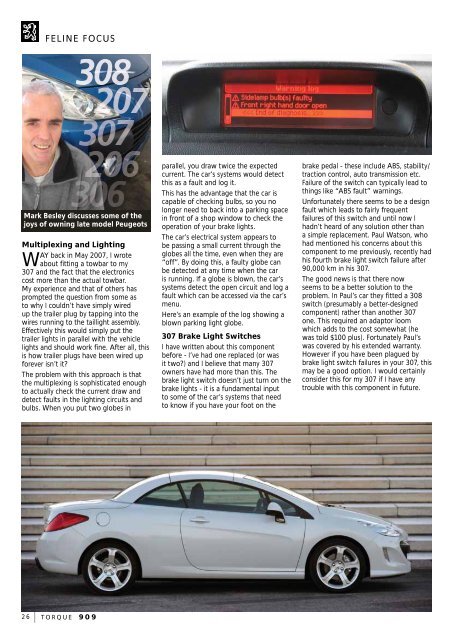Create successful ePaper yourself
Turn your PDF publications into a flip-book with our unique Google optimized e-Paper software.
FELINE FOCUS<br />
Mark Besley discusses some of the<br />
joys of owning late model Peugeots<br />
Multiplexing and Lighting<br />
WAY back in May 2007, I wrote<br />
about fitting a towbar to my<br />
307 and the fact that the electronics<br />
cost more than the actual towbar.<br />
My experience and that of others has<br />
prompted the question from some as<br />
to why I couldn’t have simply wired<br />
up the trailer plug by tapping into the<br />
wires running to the taillight assembly.<br />
Effectively this would simply put the<br />
trailer lights in parallel with the vehicle<br />
lights and should work fine. After all, this<br />
is how trailer plugs have been wired up<br />
forever isn’t it?<br />
The problem with this approach is that<br />
the multiplexing is sophisticated enough<br />
to actually check the current draw and<br />
detect faults in the lighting circuits and<br />
bulbs. When you put two globes in<br />
26<br />
TORQUE 909<br />
parallel, you draw twice the expected<br />
current. The car’s systems would detect<br />
this as a fault and log it.<br />
This has the advantage that the car is<br />
capable of checking bulbs, so you no<br />
longer need to back into a parking space<br />
in front of a shop window to check the<br />
operation of your brake lights.<br />
The car’s electrical system appears to<br />
be passing a small current through the<br />
globes all the time, even when they are<br />
“off”. By doing this, a faulty globe can<br />
be detected at any time when the car<br />
is running. If a globe is blown, the car’s<br />
systems detect the open circuit and log a<br />
fault which can be accessed via the car’s<br />
menu.<br />
Here’s an example of the log showing a<br />
blown parking light globe.<br />
307 Brake Light Switches<br />
I have written about this component<br />
before - I’ve had one replaced (or was<br />
it two?) and I believe that many 307<br />
owners have had more than this. The<br />
brake light switch doesn’t just turn on the<br />
brake lights - it is a fundamental input<br />
to some of the car’s systems that need<br />
to know if you have your foot on the<br />
brake pedal - these include ABS, stability/<br />
traction control, auto transmission etc.<br />
Failure of the switch can typically lead to<br />
things like “ABS fault” warnings.<br />
Unfortunately there seems to be a design<br />
fault which leads to fairly frequent<br />
failures of this switch and until now I<br />
hadn’t heard of any solution other than<br />
a simple replacement. Paul Watson, who<br />
had mentioned his concerns about this<br />
component to me previously, recently had<br />
his fourth brake light switch failure after<br />
90,000 km in his 307.<br />
The good news is that there now<br />
seems to be a better solution to the<br />
problem. In Paul’s car they fitted a 308<br />
switch (presumably a better-designed<br />
component) rather than another 307<br />
one. This required an adaptor loom<br />
which adds to the cost somewhat (he<br />
was told $100 plus). Fortunately Paul’s<br />
was covered by his extended warranty.<br />
However if you have been plagued by<br />
brake light switch failures in your 307, this<br />
may be a good option. I would certainly<br />
consider this for my 307 if I have any<br />
trouble with this component in future.



